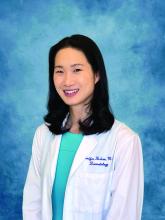User login
SAN DIEGO — .
“Research shows that the TNF-alpha and IL-17 signaling pathways have important roles in HS,” lead investigator Alexa B. Kimball, MD, MPH, from the Clinical Laboratory for Epidemiology and Applied Research in Skin at Beth Israel Deaconess Medical Center, Boston, said at the annual meeting of the American Academy of Dermatology. “However, several additional pathways are thought to contribute to disease pathogenesis.”
The presence of B cells and plasma cells has been reported in HS lesions, she continued, including early lesions, with BTK activation as a central signal transduction pathway. For the current study, Dr. Kimball and colleagues evaluated the safety and efficacy of remibrutinib (LOU064), an oral, highly selective BTK inhibitor, in 77 adults with moderate to severe HS for at least 12 months in 2 or more anatomical areas with 15 or fewer tunnels beneath the skin.
There were slightly more women than men and more than 90% of study participants were White. The novel drug, which is being developed by Novartis, is also under investigation in other immune-mediated inflammatory diseases, including chronic spontaneous urticaria and multiple sclerosis.
Of the 77 patients, 33 were assigned to receive 100 mg remibrutinib twice per day, 33 received a 25 mg twice-daily dose, and 11 patients received placebo twice per day. The primary endpoint was the proportion of patients who achieved a simplified Hidradenitis Suppurativa Clinical Response (HiSCR) at week 16 compared with pooled placebo. A simplified HiSCR response was defined as at least a 50% reduction in total inflammatory abscess and nodule (AN) count, with no increase in draining tunnels relative to baseline.
Dr. Kimball, professor of dermatology at Harvard University, reported that 80.2% of patients overall completed treatment: 87.9% and 78.8% in the remibrutinib 25 mg and 100 mg arms, respectively, and 76% in the pooled placebo arm. The main reason for treatment discontinuation was patient decision (60.9%). Nearly three quarters of patients in the remibrutinib 25 mg twice-daily arm (72.7%) achieved the simplified HiSCR endpoint, compared with 48.5% of those in the remibrutinib 100 mg twice-daily arm, and 34.7% of those in the placebo arm.
In other exploratory findings, HiSCR, HiSCR 75, and HiSCR 90 rates were higher at week 16 among patients in both remibrutinib treatment arms compared with placebo, and the study drug also was associated with a greater effect on reduction of the AN count and draining tunnels. Specifically, the estimated mean percentage reduction in AN count was 68% in the 25 mg twice-daily arm, compared with reductions of 57% in the 100 mg twice-daily arm and 49.7% in the placebo arm, respectively. Meanwhile, the estimated mean reductions in draining tunnels were 55.6%, 43.6%, and 10.2%, respectively, in the three arms.
The researchers also observed a greater response on the Patient’s Global Assessment of Skin Pain Numeric Rating Scale 30 (NRS30) in patients treated with remibrutinib compared with those on placebo at week 16 (57.1% in the 100 mg twice-daily arm, compared with 44.4% in the 25 mg twice-daily arm, and 30.4% in the placebo arm).
In terms of safety, adverse events (AEs) were mainly mild or moderate in severity, Dr. Kimball said, with no deaths and only one serious AE reported in each treatment arm: one case of acute pancreatitis in the 25 mg twice-daily arm, a testicular abscess in the pooled placebo arm, and a hypertensive crisis in the 100 mg twice-daily arm. Treatment discontinuations because of AEs were uncommon. Infections (primarily upper respiratory infections such as nasopharyngitis) were the most common AEs in all treatment arms.
“BTK inhibition may emerge as a promising therapeutic option in HS,” Dr. Kimball concluded. “This is wonderful news for our HS community. We are looking forward to determining what the optimal dosing will be going forward.”
Jennifer L. Hsiao, MD, associate professor of dermatology and director of the HS clinic at the University of Southern California, Los Angeles, who was asked to comment on the study, said there is “a pressing need for more treatments for patients with HS who suffer from the pain and oftentimes life-limiting nature of this condition.” She characterized the study results as “promising.”
“We will see if phase 3 trials with more balanced demographics across remibrutinib and placebo arms will reproduce these outcomes,” she continued, “It is exciting to see this potential new medication for HS under continued investigation, especially in light of the current gap in oral therapeutic options for the HS patient community.” Dr. Hsiao was not involved with the study.
Dr. Kimball disclosed numerous conflicts of interest from various pharmaceutical companies, including the receipt of research grants and consulting fees from Novartis. Dr. Hsiao disclosed that she is a member of the board of directors for the Hidradenitis Suppurativa Foundation. She has also served as a consultant for AbbVie, Aclaris, Boehringer Ingelheim, Incyte, Novartis, and UCB; as a speaker for AbbVie, Novartis, and UCB; and as an investigator for Amgen, Boehringer Ingelheim, and Incyte.
A version of this article appeared on Medscape.com.
SAN DIEGO — .
“Research shows that the TNF-alpha and IL-17 signaling pathways have important roles in HS,” lead investigator Alexa B. Kimball, MD, MPH, from the Clinical Laboratory for Epidemiology and Applied Research in Skin at Beth Israel Deaconess Medical Center, Boston, said at the annual meeting of the American Academy of Dermatology. “However, several additional pathways are thought to contribute to disease pathogenesis.”
The presence of B cells and plasma cells has been reported in HS lesions, she continued, including early lesions, with BTK activation as a central signal transduction pathway. For the current study, Dr. Kimball and colleagues evaluated the safety and efficacy of remibrutinib (LOU064), an oral, highly selective BTK inhibitor, in 77 adults with moderate to severe HS for at least 12 months in 2 or more anatomical areas with 15 or fewer tunnels beneath the skin.
There were slightly more women than men and more than 90% of study participants were White. The novel drug, which is being developed by Novartis, is also under investigation in other immune-mediated inflammatory diseases, including chronic spontaneous urticaria and multiple sclerosis.
Of the 77 patients, 33 were assigned to receive 100 mg remibrutinib twice per day, 33 received a 25 mg twice-daily dose, and 11 patients received placebo twice per day. The primary endpoint was the proportion of patients who achieved a simplified Hidradenitis Suppurativa Clinical Response (HiSCR) at week 16 compared with pooled placebo. A simplified HiSCR response was defined as at least a 50% reduction in total inflammatory abscess and nodule (AN) count, with no increase in draining tunnels relative to baseline.
Dr. Kimball, professor of dermatology at Harvard University, reported that 80.2% of patients overall completed treatment: 87.9% and 78.8% in the remibrutinib 25 mg and 100 mg arms, respectively, and 76% in the pooled placebo arm. The main reason for treatment discontinuation was patient decision (60.9%). Nearly three quarters of patients in the remibrutinib 25 mg twice-daily arm (72.7%) achieved the simplified HiSCR endpoint, compared with 48.5% of those in the remibrutinib 100 mg twice-daily arm, and 34.7% of those in the placebo arm.
In other exploratory findings, HiSCR, HiSCR 75, and HiSCR 90 rates were higher at week 16 among patients in both remibrutinib treatment arms compared with placebo, and the study drug also was associated with a greater effect on reduction of the AN count and draining tunnels. Specifically, the estimated mean percentage reduction in AN count was 68% in the 25 mg twice-daily arm, compared with reductions of 57% in the 100 mg twice-daily arm and 49.7% in the placebo arm, respectively. Meanwhile, the estimated mean reductions in draining tunnels were 55.6%, 43.6%, and 10.2%, respectively, in the three arms.
The researchers also observed a greater response on the Patient’s Global Assessment of Skin Pain Numeric Rating Scale 30 (NRS30) in patients treated with remibrutinib compared with those on placebo at week 16 (57.1% in the 100 mg twice-daily arm, compared with 44.4% in the 25 mg twice-daily arm, and 30.4% in the placebo arm).
In terms of safety, adverse events (AEs) were mainly mild or moderate in severity, Dr. Kimball said, with no deaths and only one serious AE reported in each treatment arm: one case of acute pancreatitis in the 25 mg twice-daily arm, a testicular abscess in the pooled placebo arm, and a hypertensive crisis in the 100 mg twice-daily arm. Treatment discontinuations because of AEs were uncommon. Infections (primarily upper respiratory infections such as nasopharyngitis) were the most common AEs in all treatment arms.
“BTK inhibition may emerge as a promising therapeutic option in HS,” Dr. Kimball concluded. “This is wonderful news for our HS community. We are looking forward to determining what the optimal dosing will be going forward.”
Jennifer L. Hsiao, MD, associate professor of dermatology and director of the HS clinic at the University of Southern California, Los Angeles, who was asked to comment on the study, said there is “a pressing need for more treatments for patients with HS who suffer from the pain and oftentimes life-limiting nature of this condition.” She characterized the study results as “promising.”
“We will see if phase 3 trials with more balanced demographics across remibrutinib and placebo arms will reproduce these outcomes,” she continued, “It is exciting to see this potential new medication for HS under continued investigation, especially in light of the current gap in oral therapeutic options for the HS patient community.” Dr. Hsiao was not involved with the study.
Dr. Kimball disclosed numerous conflicts of interest from various pharmaceutical companies, including the receipt of research grants and consulting fees from Novartis. Dr. Hsiao disclosed that she is a member of the board of directors for the Hidradenitis Suppurativa Foundation. She has also served as a consultant for AbbVie, Aclaris, Boehringer Ingelheim, Incyte, Novartis, and UCB; as a speaker for AbbVie, Novartis, and UCB; and as an investigator for Amgen, Boehringer Ingelheim, and Incyte.
A version of this article appeared on Medscape.com.
SAN DIEGO — .
“Research shows that the TNF-alpha and IL-17 signaling pathways have important roles in HS,” lead investigator Alexa B. Kimball, MD, MPH, from the Clinical Laboratory for Epidemiology and Applied Research in Skin at Beth Israel Deaconess Medical Center, Boston, said at the annual meeting of the American Academy of Dermatology. “However, several additional pathways are thought to contribute to disease pathogenesis.”
The presence of B cells and plasma cells has been reported in HS lesions, she continued, including early lesions, with BTK activation as a central signal transduction pathway. For the current study, Dr. Kimball and colleagues evaluated the safety and efficacy of remibrutinib (LOU064), an oral, highly selective BTK inhibitor, in 77 adults with moderate to severe HS for at least 12 months in 2 or more anatomical areas with 15 or fewer tunnels beneath the skin.
There were slightly more women than men and more than 90% of study participants were White. The novel drug, which is being developed by Novartis, is also under investigation in other immune-mediated inflammatory diseases, including chronic spontaneous urticaria and multiple sclerosis.
Of the 77 patients, 33 were assigned to receive 100 mg remibrutinib twice per day, 33 received a 25 mg twice-daily dose, and 11 patients received placebo twice per day. The primary endpoint was the proportion of patients who achieved a simplified Hidradenitis Suppurativa Clinical Response (HiSCR) at week 16 compared with pooled placebo. A simplified HiSCR response was defined as at least a 50% reduction in total inflammatory abscess and nodule (AN) count, with no increase in draining tunnels relative to baseline.
Dr. Kimball, professor of dermatology at Harvard University, reported that 80.2% of patients overall completed treatment: 87.9% and 78.8% in the remibrutinib 25 mg and 100 mg arms, respectively, and 76% in the pooled placebo arm. The main reason for treatment discontinuation was patient decision (60.9%). Nearly three quarters of patients in the remibrutinib 25 mg twice-daily arm (72.7%) achieved the simplified HiSCR endpoint, compared with 48.5% of those in the remibrutinib 100 mg twice-daily arm, and 34.7% of those in the placebo arm.
In other exploratory findings, HiSCR, HiSCR 75, and HiSCR 90 rates were higher at week 16 among patients in both remibrutinib treatment arms compared with placebo, and the study drug also was associated with a greater effect on reduction of the AN count and draining tunnels. Specifically, the estimated mean percentage reduction in AN count was 68% in the 25 mg twice-daily arm, compared with reductions of 57% in the 100 mg twice-daily arm and 49.7% in the placebo arm, respectively. Meanwhile, the estimated mean reductions in draining tunnels were 55.6%, 43.6%, and 10.2%, respectively, in the three arms.
The researchers also observed a greater response on the Patient’s Global Assessment of Skin Pain Numeric Rating Scale 30 (NRS30) in patients treated with remibrutinib compared with those on placebo at week 16 (57.1% in the 100 mg twice-daily arm, compared with 44.4% in the 25 mg twice-daily arm, and 30.4% in the placebo arm).
In terms of safety, adverse events (AEs) were mainly mild or moderate in severity, Dr. Kimball said, with no deaths and only one serious AE reported in each treatment arm: one case of acute pancreatitis in the 25 mg twice-daily arm, a testicular abscess in the pooled placebo arm, and a hypertensive crisis in the 100 mg twice-daily arm. Treatment discontinuations because of AEs were uncommon. Infections (primarily upper respiratory infections such as nasopharyngitis) were the most common AEs in all treatment arms.
“BTK inhibition may emerge as a promising therapeutic option in HS,” Dr. Kimball concluded. “This is wonderful news for our HS community. We are looking forward to determining what the optimal dosing will be going forward.”
Jennifer L. Hsiao, MD, associate professor of dermatology and director of the HS clinic at the University of Southern California, Los Angeles, who was asked to comment on the study, said there is “a pressing need for more treatments for patients with HS who suffer from the pain and oftentimes life-limiting nature of this condition.” She characterized the study results as “promising.”
“We will see if phase 3 trials with more balanced demographics across remibrutinib and placebo arms will reproduce these outcomes,” she continued, “It is exciting to see this potential new medication for HS under continued investigation, especially in light of the current gap in oral therapeutic options for the HS patient community.” Dr. Hsiao was not involved with the study.
Dr. Kimball disclosed numerous conflicts of interest from various pharmaceutical companies, including the receipt of research grants and consulting fees from Novartis. Dr. Hsiao disclosed that she is a member of the board of directors for the Hidradenitis Suppurativa Foundation. She has also served as a consultant for AbbVie, Aclaris, Boehringer Ingelheim, Incyte, Novartis, and UCB; as a speaker for AbbVie, Novartis, and UCB; and as an investigator for Amgen, Boehringer Ingelheim, and Incyte.
A version of this article appeared on Medscape.com.
FROM AAD 2024


